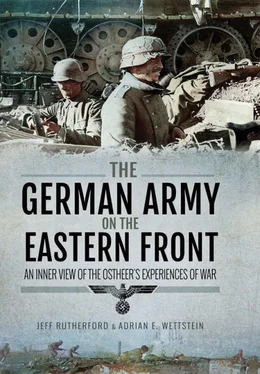[…]
The meaning of Military-Ideological Care
As the experiences of the First World War taught, next to the outer totalization of the war within the military and economic respects and in the area of labour mobilization, a so-called inner totalization must also take place to confront war weariness from the start as well as its scattered appearances and the ebbing of the spirit of resistance through instruction, clarification and easing of tension.
This occurs through the mobilization and the arousal or stimulation of all mental-spiritual powers in each man, with the goal to remove any doubts and to support and strengthen his will to resist. Such help is all the more necessary the longer the war lasts and the more that the Russian space and war situation burden the mind and soul of every soldier.
The threatening degeneration of the soldiers into primitive, Russian-like brutes should be worked against through constant clarification of the situation, discussions about the point and goal of this war, explanations about the state leadership’s measures, and action against enemy propaganda, etc. through the spoken word.
As discussed in the chapter on training, preparing the soldiers for the stresses and strains of combat was clearly a priority for the German army as it realized that the quality of the German soldier would have to make good the numerical inferiority of the army.
Following the army’s defeat in the First World War, the Reichswehr continued this process, though the emergence of the Nazi regime in 1933 and the close links forged between Hitler and the defence minister, Werner von Blomberg, led to an increase in specifically National Socialist indoctrination. Such a programme was due in part to the army’s leadership attempt to ensure its relatively privileged position within the Third Reich as one of the two (alongside the Nazi Party) pillars of the National Socialist state and in part to Blomberg’s admiration of Hitler. He initiated a series of policies designed to draw the army closer to the regime, including the adoption of the Aryan paragraph, the oath to Hitler following President Hindenburg’s death, and, most notoriously, the army’s active participation in the elimination of the SA leadership during the Night of Long Knives. As German historian Wilhelm Deist has noted, ‘all this meant that the “adaptation” and “opening” of the Wehrmacht amounted to a process of almost complete ideological assimilation into the National Socialist regime.’ [12]This development was certainly not welcomed by the army’s entire leadership, however, and individuals such as Generaloberst Werner von Fritsch and Generaloberst Ludwig Beck strove to maintain the army’s traditional outlook and powers. It was only in 1938 – the year of the Blomberg–Fritsch Crisis – that the regime finally gained the upper hand in its struggle with the army leadership.
The fault lines between the two institutions were laid bare during the invasion and occupation of Poland. Campaigns of murder and forced deportation carried out by the SS aroused army opposition in the autumn and winter of 1939. Hitler quickly solved this problem by granting amnesty to anyone who committed crimes during the campaign, but it had demonstrated to the Nazi leadership that the army was not yet sufficiently prepared to wage the war desired by the regime. It therefore renewed efforts to transform the army’s mindset. These efforts especially expanded following the defeat of France in autumn 1940, as the army prepared for the war with the Soviet Union. Coinciding with the establishment of new infantry divisions for Operation Barbarossa, the OKH issued an order in October 1940 that directed officers on how to properly instruct their soldiers for the upcoming campaign. [13]
Ideological Education
In war, a far greater part of the male population fit for military service stands under weapons than in peacetime. For numerous soldiers, this means a considerable lengthening of their time in the service. The Wehrmacht accepts and takes on this task to a greater extent [than other organizations and] therefore expands to educate the soldiers ideologically [ weltanschaulich ] and national-politically, in addition to weapons’ training. No doubts can exist that the training of the soldier to be a determined warrior who enthusiastically attacks cannot be separated from a vital national socialist education.
All superiors therefore are to pay special attention to this. In so doing it is not so important to deal with as many themes as possible. What is decisive is that a unified conception exists in the army about National Socialist foundations and that they become the intrinsic values of all soldiers.
The troop commander is alone responsible for the spirit and the attitude of his soldiers. Therefore ideological education of the troops is also his task. This task is of far-reaching importance for the army’s schools and courses. The ‘Guidelines for the Ideological Instruction’ (enclosure) serves as an indication. […] Guidelines for Ideological Instruction
The soldier also requires [guidance] in ideological and national socialist areas. Ideological instruction is especially successful when it occurs through a troop commander who knows his men.
The means for ideological instruction and spiritual care are:
Lectures about National Socialist basic principles, reading matter, film, radio, free-time activities. At the same time, the personally spoken word of a spiritually stirring and fresh officer to his troops is always the best means for the soldiers’ ideological education.
I) Lectures by the troop commander or lecturer to the troops about national socialist fundamentals.
Theme 1: The German Volk
Main point: Clean race, health and capable women. Many children. Soldier replacements (military strength). How many recruits has Germany, for example, in 20 years? Fleeing from the land – a danger for the nation’s racial foundations [ Volkstum ].
Documents: The Führer’s book, ‘ Mein Kampf ’; ‘People in Danger’ from Otto Helmut; ‘People and Race,’ an illustrated monthly; ‘Racial Studies of the German people’ Prof. Dr. Hans Günther; ‘Population Development in the Third Reich,’ by Burgdörffer
Theme 2: The German Empire
Main point: The Structure of the State. Party and Wehrmacht as the pillars of the state. Führer state. Responsibility up. ‘State’ as living form of the people. From the military strength of healthy people will become the Wehrmacht of the strong state. Prerequisite: utilization of societal manpower.
Documents: The Führer’s book, ‘ Mein Kampf ’; the defence law Theme 3: German Living Space Main Point: Goal of the war: securing the German living-(economic)-space, not subjugating the neighbouring peoples. ‘Autarky’ – Import – Independence for goods necessary for existence. The smaller in protection by the larger peoples.
Theme 4: The National Socialism as Foundation
Main point: a) for a healthy and unified people (see theme 1).
German socialism and front camaraderie (as result of National Socialist instruction!)
b) for a strong empire (see theme 2). Strong leadership. Labour and full utilization of societal manpower. ‘Work ennobles.’ ‘Military service is honourable service.’ (Domestic politics!)
c) for the securing of living space. (Foreign policy!)
As this order indicates, the traditional spiritual care that officers were responsible for now took on more National Socialist overtones, thus further politicizing the army and its officer corps. The various lectures highlighted the army’s attempt to show the close bond between itself and the Nazi regime, as well as attempt to explain to its soldiers – through the use of Nazi rhetoric regarding race, living space, and Volksgemeinschaft – the necessity of the present war.
Читать дальше






![John Stieber - Against the Odds - Survival on the Russian Front 1944-1945 [2nd Edition]](/books/405234/john-stieber-against-the-odds-survival-on-the-russian-front-1944-1945-2nd-edition-thumb.webp)





